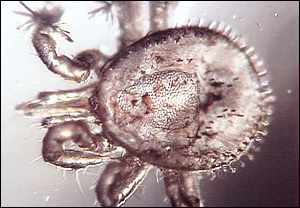Tick could have had dino diet

Carios
jerseyi: The oldest blood-sucking tick yet discovered
A 90-million-year-old
tick, fossilised in amber, and which could have fed on the blood of dinosaurs, has
stirred up suggestions that it might contain the DNA of the fearsome creatures.
|
Would ticks feed on dinosaurs if dinosaurs were still around today? You bet
|
|
Prof Hans Klompen |
But the scientists in charge
of the parasite say they do not intend to turn the film Jurassic Park into
reality, as they maintain the chances of finding any readable DNA are slim.
Instead, they want to
preserve the specimen as it shows unique features not seen in modern day ticks.
The tick is the oldest
known fossil of the order Parasitiformes. Its discovery increases the order's
age by 50 million years, says Hans Klompen, professor of entomology at Ohio
State University, where the parasite is being studied.
Dinosaur
blood
Carios jerseyi, as it is technically known, is an Argasid, or soft
tick. The fossil is estimated to be between 90 and 94 million years old.
If C. jerseyi
really is that old, it could have fed off the blood of dinosaurs. "Ticks
will feed on anything that has blood," Klompen says.
"Would ticks feed
on dinosaurs if dinosaurs were still around today? You bet," he adds.
"Nearly all soft ticks will feed on a wide range of hosts. If it has
blood, a soft tick will go for it."
But the ancient tick's
precise feeding habits will remain a mystery, since scientists want to preserve
the unique specimen and not break it up.
Fed on birds
Although Carios
jerseyi lived during the height of the dinosaur era, the upper Cretaceous
period, Klompen is pessimistic that any DNA from dinosaurs could be extracted.
"You won't
reconstruct a dinosaur from the blood of a blood-feeding arthropod," he
said. The tick was discovered several years ago in a large rock excavated from an
amber outcrop in central New Jersey, US. It measures 0.520 mm by 0.445 mm (0.02
by 0.01 inches).
Scientists are puzzled
by its three dozen or so tiny bristle-like hairs aligned in two rows on its
back.
"It was very
surprising," Klompen says: "Soft ticks normally have far fewer hairs
over their entire body. But this tick is much closer to what I anticipate as
the evolutionary starting point of all ticks."
"Most of the hairs
on the body of a mite or a tick are probably contact receptors," he adds.
Feather clue
"If something gets
too close, the tick notices it's there. Other Argasidae have hairs, but they're
typically much longer and arranged chaotically."
Rather than feasting on
dinosaurs, Klompen says, it is more likely that C. jerseyi fed on
sea-faring birds.
The specimen shows
similarities to a group of ticks known for feasting on birds. And a small
feather (7.5 mm, or 0.3 inches) from an unidentified bird was also found
preserved in the same outcrop of amber.
"Finding this
feather suggests that the tick might have travelled to North America on a
seabird," Klompen said.
C. jerseyi is described in the current issue of the journal
Annals of the Entomological Society of America.
Dr DAVID WHITEHOUSE